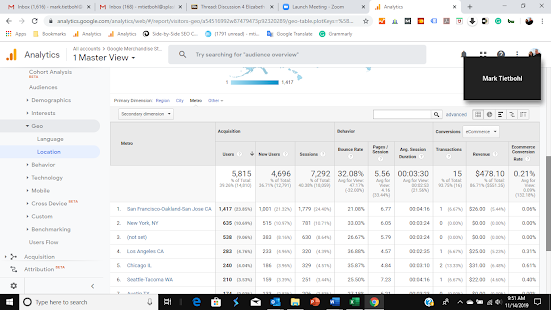Visitor Characterization and Google Analytics: Using Returning Visitor Insights to Gauge Marketing Content
- Get link
- X
- Other Apps
By: Allison Akers
This blog post is the second in a series. In the first blog post we defined the categories of metrics within Google Analytics and took a look at the visitor characterization category.
Need a recap? Check out the first
post here.
While the new visitors metric is important to track, the visitor
characterization category is more than just measuring new visitors. Returning
users is also a key metric that can provide valuable insight for a company.
New vs Returning Visitors
In the prior blog post we learned that a new visitor is
defined by Tietbohl (2022) as the “number of unique visitors with activity
including a first-ever visit to a site during a reporting period.” Hotjar
(n.d.) notes that:
“according to Google’s tracking snippet;
returning users have visited your site before. When someone views your website,
Google’s tracking snippet looks for a tracking cookie on their device:
-If the cookie is not present,
Google creates one and considers this a ‘new’ user
-If the cookie is present, Google
considers this a ‘returning’ user and starts a new session.”
A drop in returning visitors could mean that content isn’t
delivering what the consumer needs to get them to convert to a goal (Eckerling,
2014). Therefore, returning visitors is still an important metric to keep an
eye on. Especially as it relates to actual sales and the tracking of sales
volume versus any significant differences in new users versus returning users.
However, as Hotjar (n.d.) points out, “Google Analytics
can’t tell you why new visitors are behaving in a certain way and returning
ones exhibit a different behavior, and if you want to find out you have to do
some more investigating of your own.” Therefore, this data can give you enough
insight to ask further questions and dive in deeper to experimentations and
customer behavior views. It is not an all-encompassing view in itself.
Returning Visitors Use Case
Vision Technologies (Vision) is a leading technology systems
integrator with clients spanning Fortune 500 companies and thousands of customers
across all 50 states. Vision specializes in five different business units,
offering services such as AV solutions, infrastructure cabling, physical
security solutions, wireless connectivity and mobility solutions, and managed
IT services support (Vision Technologies, n.d.). The company is uniquely
positioned to help both new customers, but also focus on adding services and
support on for existing customers. Especially as the company began offering return-to-work
solutions and technology upgrade contracts. Therefore, keeping an eye on
returning visitors is still an important metric. Returning visitors could
encompass existing customers that may be in need of new solutions but also visitors
that may have visited before but not converted as a bidded proposal customer.
Another unique insight into returning visitors related to
Vision Technologies is that general contractors (aka constructions companies) are
also a large segment that bring in end user leads. Therefore, we want them to
continue to return to our website in order to reach out when they have a building
they are working on.
Let’s take a look at how returning visitors stands up from 2021 versus 2020 in the aggregate of all website users:
When segmented out by top performing business units,
wireless is the consistent business unit pulling in repeat visitors with ITS (the
structured cabling group) as a close second. However, ITS dropped in 2021,
drawing in more new visitors. AV, while drawing lower repeat visitors overall,
also saw a drop in 2021 as compared to 2020.
Conclusion
Understanding the metrics of new versus returning visitors is an important base. But it’s taking it further and gleaning insight into the behaviors of these users that will provide the most useful insights. Hines (2014) puts it best by stating “by using goals in Google Analytics, you can track the behavioral patterns of visitors who are most likely to convert. For example, you’ll know if you’re most likely to get the most conversions on a visitor’s first visit or returning visits.” From there you can adjust your marketing efforts to spend the most time on optimizing conversions with the easiest ROI.
References
Google Analytics.
(2022). Analytics: Vision Technologies audience overview 20210101-20211231-20200101-20201231.
Unpublished internal company document.
Google Analytics.
(2022). Analytics: Vision Technologies audience overview segments 20210101-20210331-20200101-20200331.
Unpublished internal company document.
Hines, K. (2014,
July 15). How to use Google Analytics audience data to improve your marketing.
Social Media Examiner. Retrieved https://www.socialmediaexaminer.com/google-analytics-audience-data/
Hotjar. (n.d.).
Google Analytics users. Hotjar Guides. Retrieved January 23, 2022 from https://www.hotjar.com/google-analytics/glossary/users/
Tietbohl, M. (2022,
January). Week 1 lesson: intro to web analytics and the basic of web analytics/tool
introduction and selection. Ecampus. Retrieved from West Virginia
University, IMC 642.
Vision Technologies. (n.d.). Homepage. Retrieved January 23, 2022 from https://www.visiontechnologies.com/
- Get link
- X
- Other Apps





Comments
Post a Comment
Thank you for your comment! I will get back to you shortly!